#fredric wertham
Photo


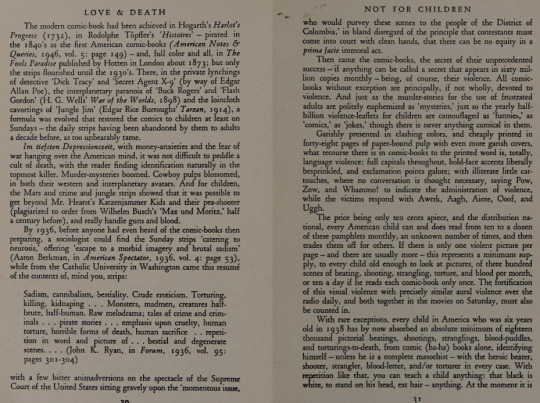
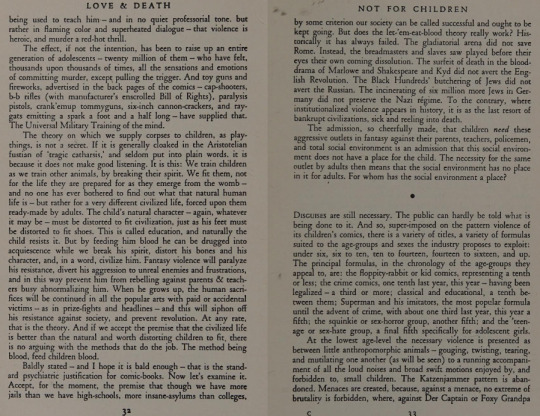
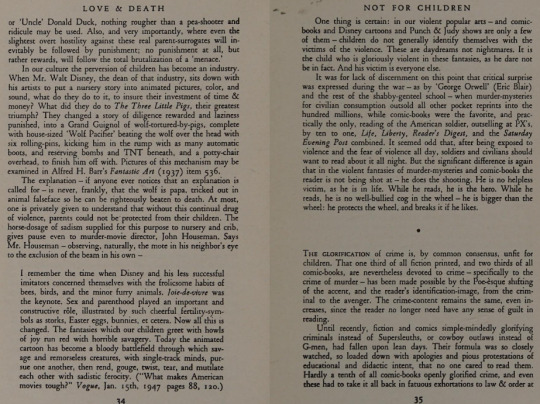
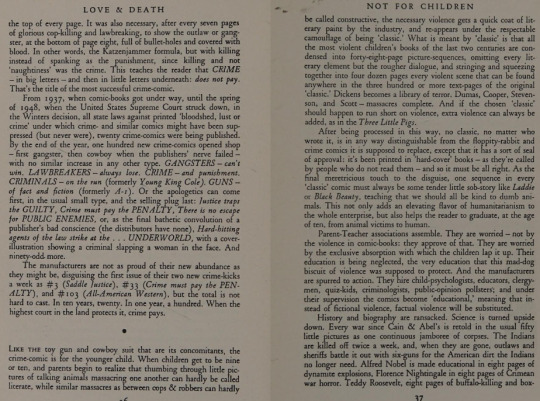
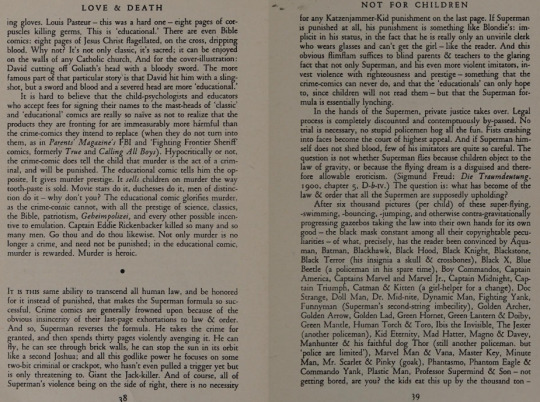

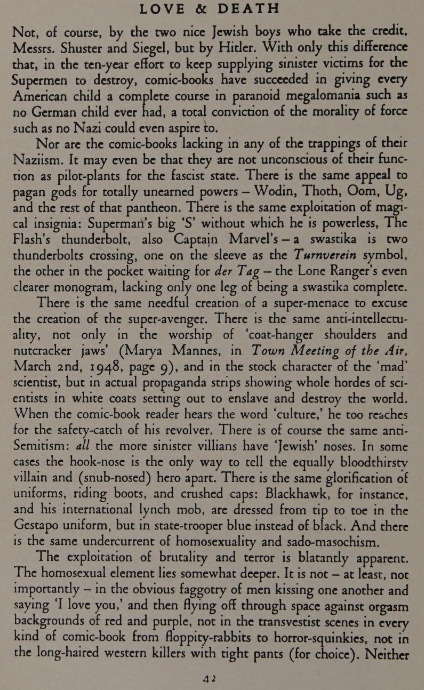

The aggressive content of comic books is so conspicuous that most observers fail to notice that this aggression is rigidly channelized, that the willingness of any reader to accept a fantasy escape from his frustrations presupposes a willingness to achieve less than total and actual escape. Like all other forms of dreaming, literature operates under a censorship. And this censorship -- in both its legal and internalized expression -- does not allow any direct, total attack on the frustration that elicits the dream. It offers a choice.
- Love and Death: A Study in Censorship (1949), Gershon Legman
Five years before Fredric Wertham’s infamous Seduction of the Innocent essay and the subsequent spark of anti-comic sentiment that nearly killed the industry along with the introduction of the Comics Code Authority and the Senate Subcommittee Hearing into Juvenile Delinquency, Gershon Legman had explored similarly sentiments in Love and Death: A Study in Censorship (1949).
The belief that the violence of pre-code comics was harmful to children and the approach of the ‘Superman model’ as inherently fascist explored in Legman’s work would form much of the basis for Wertham’s later criticism and the crusade against comics. Interestingly enough, Gershon Legman is widely believe to have been gay himself.
#love and death#love and death 1949#love and death: a study in censorship#gershon legman#fredric wertham#seduction of the innocent#anti-comics sentiment#anti comics sentiment#comics censorship#comic book history#u can reblog#i thought this was immensely interesting and obvious nonsense aside i think it brings up much better points than wertham's nonsense#primarily because legman is legitimately concerned w the portrayal of villains are racialized caricatures in some way or another#vs the white conventionally attractive socially acceptable hero by default#and thats a very interesting sentiment for 1949#equally interesting is the wording in regards to what exactly this portrayed mindless violence is supposed to do and i would agree w it#to the extent regarding. say. present day military propaganda in superhero movies#theres a lot to be said about it but id say its wildly interesting#and then extremely funny when it implies all aac and dc employes were gay. hell i wish#the end is obviously nonsense but i think it does read differently coming from a gay man#thoughts anybody?
15 notes
·
View notes
Text
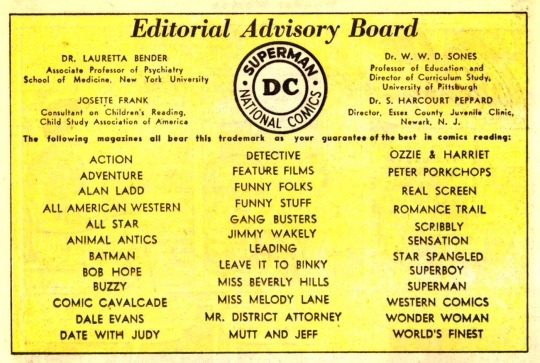
DC's Editorial Advisory Board, as shown in Wonder Woman #41, May-June 1950, Dr. Lauretta Bender, associate professor of psychiatry, Josette Frank, consultant on children's reading, Dr. W. W. Sones, professor of education and director of curriculum study, Dr. S. Harcourt Peppard, director, Essex County juvenile clinic. Note the number of licensed comics and diversity of genres–Western, crime, funny animals, humor, and only a handful of super-heroes.
To learn more about Josette Frank and her fight for comics, here's the first article of a 5-part series entitled Josette Frank: Alone Against the Storm. This is a must read if you're at all interested in Golden Age comics, early Wonder Woman and Superman, and the history of censorship. Here's a letter from Frank to Wertham (from part 4):
January 23, 1948
Dear Dr. Wertham,
I was greatly interested in your presentation this morning on the McCaffrey [sic] program concerning comic books and particularly in your statement that "99 % of the comics" contain obscene material.
I am wondering whether you would be good enough to let me know where I can locate the data on which this is based. It is certainly a very frightening figure to give parents and ought to be substantiated by sound data.
As you possibly know, I have been interested and concerned with comic books for a number of years as part of my work in the field of children's reading. I have done considerable work with them and I thought I knew them pretty well, but it seems evident that you have made some studies or have access to data which I do not have and would like to study.
For the past year or so I have been concerned, as you are, about the growing number of new comic books with a sex interest. These are certainly an aberration of the earlier content of both comic books and comic strips. I should have guessed, roughly, without any careful tabulation that they comprise a fairly small percentage (though still too many) of the total number of some 250 titles on the news stands. I am amazed at the figure you find.
Will you be good enough to let me know the basis on which this conclusion was arrived at?
7 notes
·
View notes
Text

Gary Groth, Michael Dean & Kristy Valenti (ed.): The Comics Journal #302 (2013)
#the comics journal#tcj#comics#criticism#maurice sendak#tardi#joe sacco#gene deitch#art spiegelman#chester brown#mort weisinger#roy crane#fredric wertham#fantagraphics books
1 note
·
View note
Text




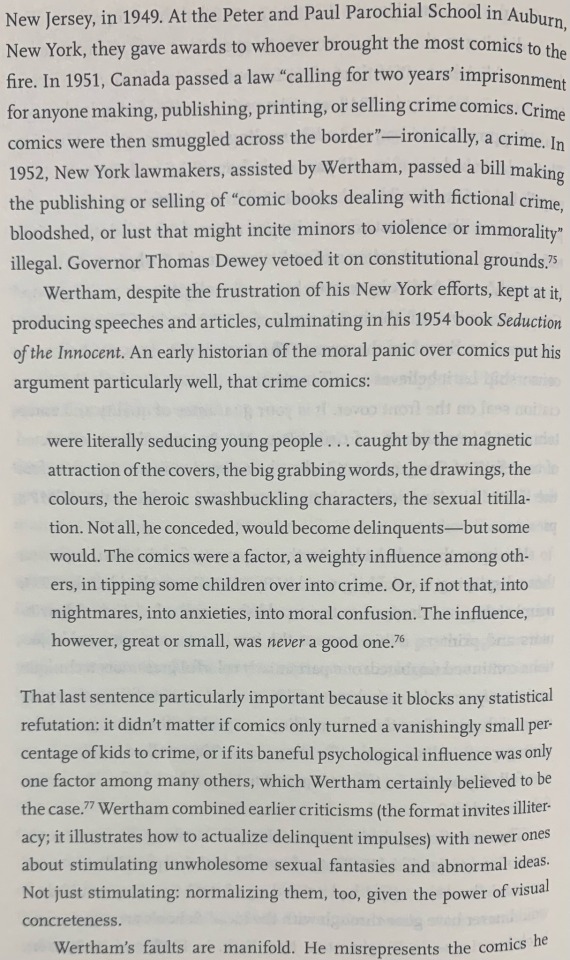


excerpt from American Comics: A History by Jeremy Dauber
1 note
·
View note
Quote
Crime books, comics and other stories packed with criminal activity and presented in such a way as to glorify crime and the criminal may be dangerous, particularly in the hands of an unstable child. A comic book which is replete with the lurid and macabre; which places the criminal in a unique position by making him a hero; which makes lawlessness attractive; which ridicules decency and honesty; which leaves the impression that graft and corruption are necessary evils of American life; which depicts the life of the criminal as exciting and glamorous may influence the susceptible boy or girl who already possesses anti-social tendencies.
FBI director J. Edgar Hoover, at the Senate Subcommittee to Investigate Juvenile Delinquency in 1950, being entirely unoriginal and of course entirely wrong
cited in Bart Beaty, Fredric Wertham and the Critique of Mass Culture (University Press of Mississippi, 2005)
#J. Edgar Hoover#comics#rogues in fiction#train them young#analysis#information wants to be free#Bart Beaty#Fredric Wertham and the Critique of Mass Culture
17 notes
·
View notes
Text
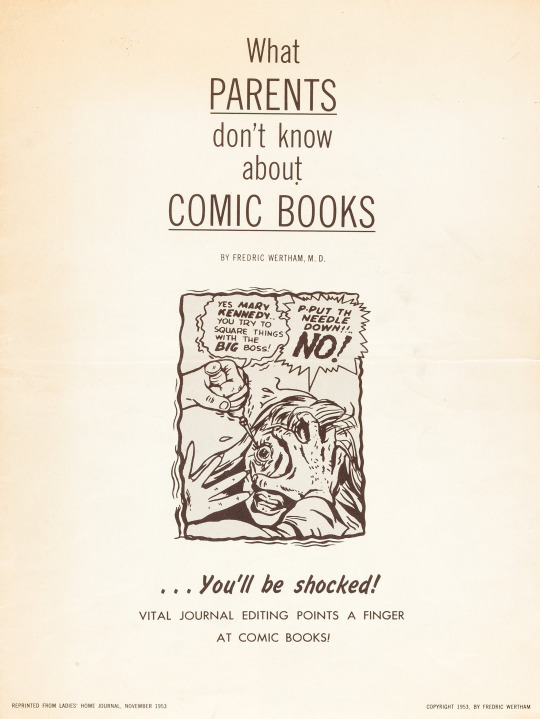
"What Parents Don't Know about Comic Books"
Seduction of the Innocent Prototype Pamphlet, "What Parents Don't Know about Comic Books" by Dr. Fredric Wertham (Ladies Home Journal & Baptist General Convention of Texas, 1953). An eight-page rehearsal for the anti-comics tirades of quack psychiatrist Wertham, whose bestselling book, Seduction of the Innocent, would help to bring about the repressive Comics Code Authority in 1954.
#seduction of innocent#dr. fredric wertham#comics code authority#censorship#paranoia#hysteria#right wing nut jobs#batshit crazy
38 notes
·
View notes
Note
can i copy you by putting the st peters quote in my pinned or is that YOUR IDEA DO NOT STEAL!!!1!!!1!111
you can do whatever you want forever
#i mean Dr Fredric Wertham is the one who said it i just took it wildly out of context and posted it on my tumblr blog#cropping it to make it positive was jamie's idea anyway
2 notes
·
View notes
Text
sorry for all of the x-men stuff. it finally dawned on me why i was deeply intrigued by the claremont signature kinky dominatrix stuff in dark phoenix as a child.
0 notes
Text
Ultimate Incest Tournament - Round 1


Propaganda under the cut:
Cersei/Jaime:
they're literally womb-to-tomb lovers. they feel that the rest of the world is beneath them and they're the only ones that matter. the fact that they're twins is fundamental to their attraction to each other
they’re blonde they’re evil they crossdress they’re fucked-up mirrors of one another they serve cunt they’re both bisexual probably and they’re TWINS who FUCK. who said that.
"if I were a woman, I'd be Cersei."
"I'll kill [...] the whole bloody lot of them until you and I are the only people left in this world."
"I am sick of being careful. The Targaryens wed brother to sister, why shouldn't we do the same? Marry me, Cersei. Stand up before the realm and say it's me you want."
"'Do you have a little wife, ser?'" No, I have a sister."
Bruce/Dick:
Adopted son Dick Grayson boywife Dick Grayson boywife
Was YOUR pairing mentioned in a 397 page callout post that changed the entire comic book industry forever? I thought so.
before John/Dean entered the scene they were doing up the militant-freudian-father/child-soldier-motherofhisotherchildren-son incestuationship in 1940!! in fact they were so flagrantly intimate that they spawned the first ever 'video games are bad for children' discourse in the form of 'comics are bad because they'll make your children yearn for the gay incest mines' i.e. seduction of the innocent by fredric wertham. and y'know maybe they were right after all *gestures to the incest poll tournament*
SO many delicious aspects of their dynamic honestly. the fact that dick made batman a father and the latter loved it (and him) so much that he sought to replace him forever and ever again and again rebecca daphne du maurier style. word on the streets (lost canon timeline) is bruce made the first replacement— jason todd— dye his hair from red to black so that he'd resemble dick, inspiring generation spanning lust for and yearning of approval from both daddy bats and first son/greatest love of aforementioned daddy bats
How many other incest pairings are so strong that they generated like at least 5 other incestuationships? the family tree branches are CRUMBLING. not to mention their dramatic breakup did give us beloved 2000's animated series teen titans.
there are so many interpretations writers like to impose on the characters. they're father/son, frankenstein and creature, brothers, husband and wife. when batman has his own biological son but then promptly "dies", dick, the first son, comes in as a father to his father's first son (whilst donning the cape and cowl/body of his partnerfather). MANY say that dick was a better parent to damian wayne than even bruce. it literally can't get more incestuous than this, sorry
#tumblr polls#tournament polls#incest poll#cersei/jamie#lannicest#game of thrones#a song of ice and fire#bruce/dick#batcest#batman#tw incest#round 1
137 notes
·
View notes
Photo

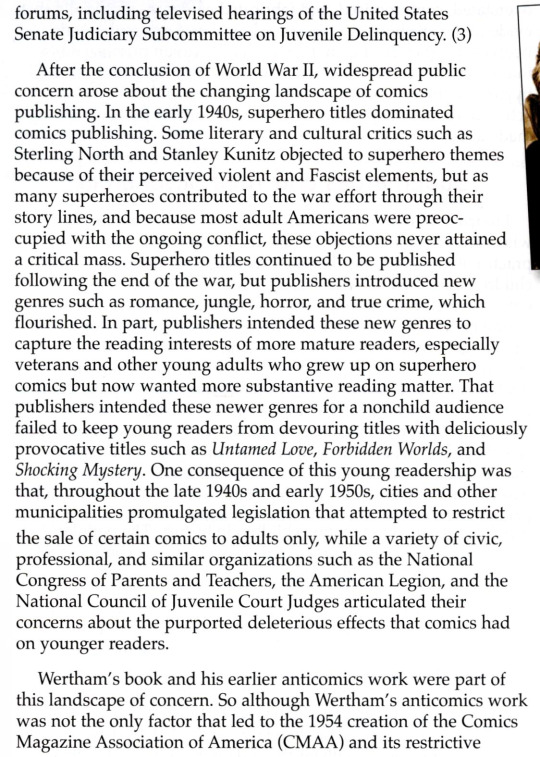





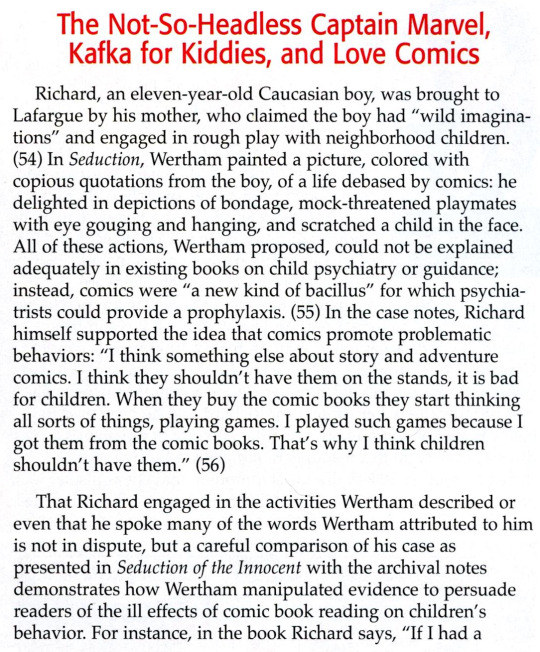
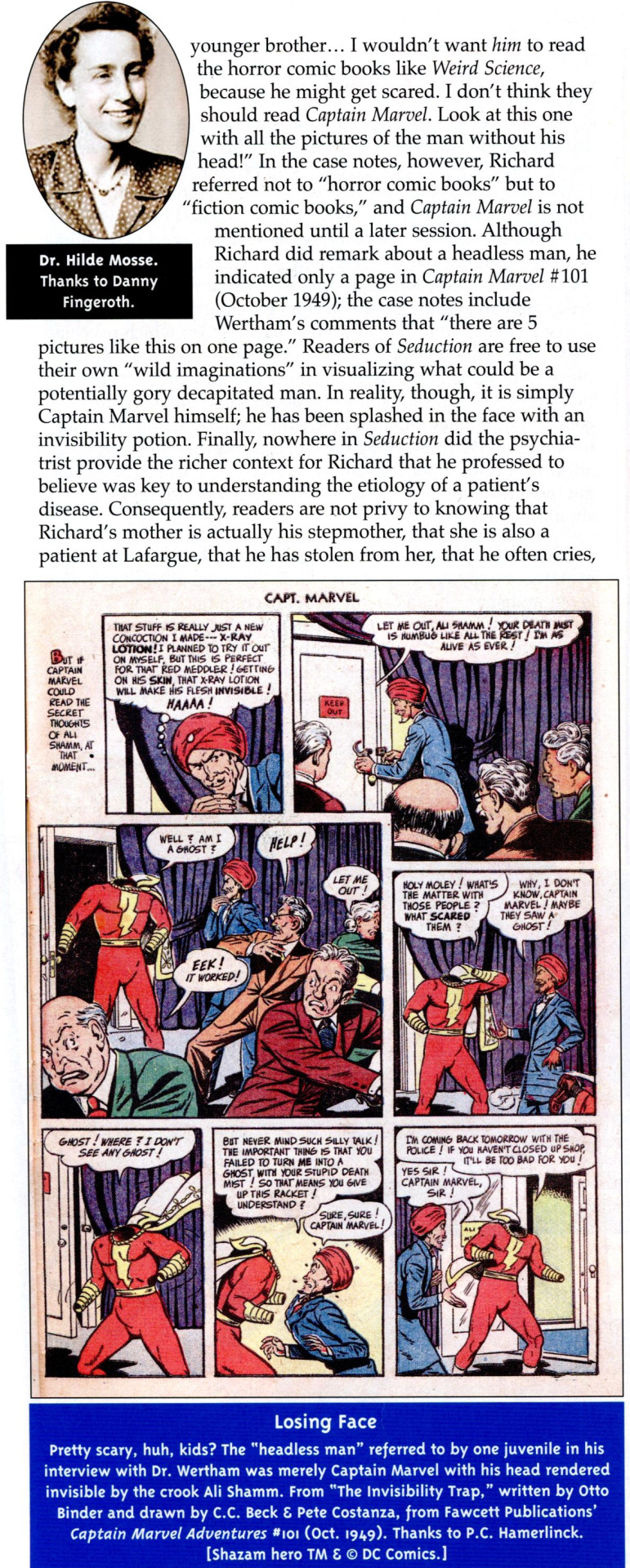
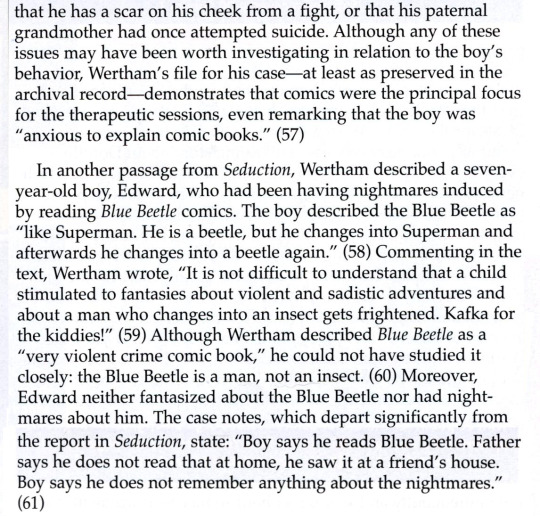
A couple interesting highlights from Carol L. Tilley’s ‘Seducing the Innocent: Fredric Wertham and the Falsifications That Helped Condemn Comics’, appearing in Alter Ego (1999) #128.
#comic book history#comics code authority#fredric wertham#seduction of the innocent#carol l tilley#batman#robin#wonder woman#captain marvel#shazam#blue beetle#dc#dc comics#u can reblog#ask to tag? i just thought this was absolutely fascinating#and the thing abt sales in 1945 vs sales in 2011? holy fuck
28 notes
·
View notes
Text
In 1954 a man named Fredric Wertham wrote a book called 'Seduction of the Innocent' -

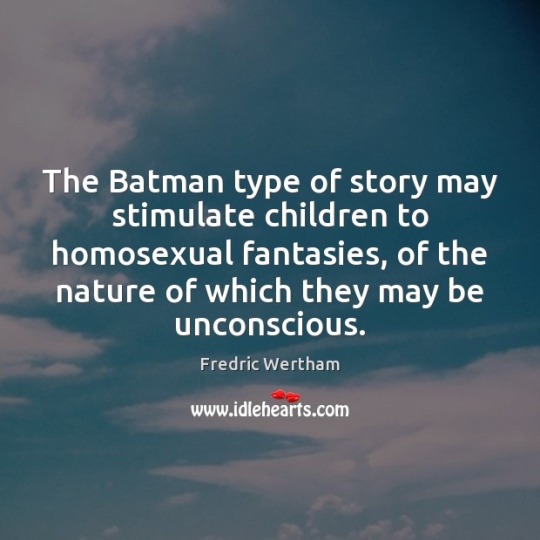
A book detailing and theorizing that violence and suggestiveness in comics and pulp fiction novels had a measurable, negative effect on the reader that inherently reflected the psyche of those who consumed them at length.
The book made Wertham famous, starting a moral panic across the country.
In Wertham's - and much of the countries eyes:

[also yes I had to verify that he did in fact say this as sourced by New Yorker Mag. Stan Lee should've kicked this antisemites ass]
In response - the Comics Code Authority was created - a code that dictated what could and couldn't be in comics, for the 'safety' of the reader.
This Code almost killed comics, almost putting Marvel out of business, until ten years later when Spider-man was created. Although it wasn't law - it was the panic of the public that enforced the Comics Code, completely sanitizing the industry for decades.
Gwen Stacy's death - a clear show of violence in panel - was one of the events to first 'break' this social code.
The issue it took place in - TASM #121 was released in 1973, almost twenty years after Wertham's moral panic.
It showed clear, unpeaceful death and tragedy, with NO resolution.
And fans ATE IT UP.
To this day, The Amazing Spider-man #121 is one of the most iconic issues in Spider-man's entire lore, with Gwen appearing in almost all of his movie franchises (Raimi, TASM, and ITSV), and her death characterizing MUCH of modern-day Spidey storytelling.
The reason I want to highlight this story is because I will always find it baffling, and SAD to see people saying that fanfiction or fandom art or favorite characters inherently reflect - or damage your psyche.
So often in fandom spaces - COMIC fandom spaces - I see this rhetoric parroted. That people who consume x are inherently more dangerous. That y shouldn't exist because it inherently damages those who consume - and enjoy it.
Unknowingly, but wholeheartedly claiming 'Seduction of the Innocent'.
That rhetoric comes from somewhere.
That idea - when it comes to video games, violent rap music, loud rock music, graphic TV shows, that such content warps the viewer simply by design - comes from one place.
Fredric Wertham, Seduction of the Innocent, and moral pubic panic.
Such an idea had a visible measurable effect on canon comics. So why does it persist in comic fandom?
They say those that do not know history are doomed to repeat it.
#just thinking out loud#spiderman#atsv#spider man#marvel#across the spiderverse#comics history#comics#itsv
51 notes
·
View notes
Text
The good news is that Penguin Random House can't buy all the other publishers

Correction: An earlier draft of this article characterized Frederic Wertham as “a far-right conspiracist.” That was incorrect. While Wertham was a conspiracist, he was not far right. I regret the error.
Last week, a US District Court blocked the merger of Penguin Random House, the world’s largest publisher, and Simon and Schuster, the world’s third-largest publisher. This is very, very good news.
https://www.npr.org/2022/11/01/1133032238/judge-blocks-penguin-random-house-simon-schuster-merger
During the trial, the Penguin Random House argued it they would continue to compete with Simon and Schuster for books, bidding against them for prized titles. Stephen King punctured this absurd fiction, noting that this was like a husband and wife bidding against each other to buy the same house:
https://www.nytimes.com/2022/08/02/business/stephen-king-penguin-random-house-antitrust-testimony.html
With the merger halted (pending appeal) the number of major trade publishers stands at five, which, while better than four, is still not very many. Practically speaking, it means that five corporate board-rooms are in charge of nearly all of our literature, deciding what gets published, what doesn’t, and how those books are sold. That is a lot of power to vest in a very small number of hands.
This concentration of power is obviously bad for authors, since a failure to sell your book to editors at a mere five houses means that it will not come out from a major publisher. As Rebecca Giblin and I document in our new book Chokepoint Capitalism, when publishing is this concentrated, copyright is largely irrelevant to authors’ fortunes:
https://chokepointcapitalism.com/
If you’re in Edinburgh, you can come to our talk about the book at the Radical Book Fair on Nov 10:
https://lighthousebookshop.com/events/chokepoint-capitalism-cory-doctorow-and-rebecca-giblin
We’ll be at Waterstones in Oxford on Nov 12:
https://www.eventbrite.co.uk/e/chokepoint-capitalism-rebecca-giblin-and-cory-doctorow-oxford-tickets-443951941207
And at The Peale Museum in Baltimore on Nov 18:
https://www.thepeale.org/event/book-talk-chokepoint-capitalism/
And I’ll be in London for Big Ideas Live on Nov 19:
https://news.sky.com/bigideaslive
Concentration in publishing is also very bad news for publishing workers, a notoriously exploited group of people, whose working conditions are so bad that 1% of the entire sector’s workforce resigned en masse last summer:
https://bookriot.com/great-publishing-resignation/
For these workers, a failure to secure a decent wage at just five employers means that they have no hope of working at any major publisher.
And for readers, all this means that the decisions about what you get to read are gathered into a vanishingly small number of hands. A tiny group of fallible humans will make decisions about what books are widely available, and, possibly even worse, a tiny group of fallible humans can be arm-twisted into not publishing works that governments or pressure groups don’t want to see printed.
In 1954, a far-right conspiracist named Fredric Wertham published a scientific hoax called “Seduction of the Innocent” that claimed that comic books were luring American children into a life of wanton sex, drug abuse and communism and/or fascism.
http://www.lostsoti.org/
Wertham whipped up a “groomer” panic about comic books and in response, bedwetting conservatives burned mountains of comics and demanded government censorship. Opportunistic lawmakers took up the cause and threatened the comics industry with unconstitutional regulation of their publishing programs.
The comics industry caved: a handful of cowardly executives formed a self-regulatory body called the “Comics Code Authority” whose seal of approval was withheld from all but the most inoffensive and bland of stories and illustrations. Most comics retailers refused to carry comics unless they bore this seal, and stores that bucked the Authority were raided and their owners fined or even jailed:
https://cbldf.org/about-us/case-files/cbldf-case-files/
The CCA continued to have veto power over most comics until the year 2000 — for nearly half a century, an unaccountable star-chamber of prudes ruled over an entire art form. That was only possible because that industry was first cornered by a handful of unaccountable executives, who then handed power to the CCA.
Readers, writers, retailers, editors and publishers all suffer under publishing monopolies. The fact that the court blocked Penguin Random House from gobbling up Simon and Schuster is good for all of us.
Except…
There’s a reason PRH wanted to devour S&S. Back in 2010, the Big Six publishers entered into an illegal conspiracy with Apple to price-fix ebooks. The publishers wanted to force Amazon to stop subsidizing the Kindle books, selling them below the publishers’ wholesale cost, and ensuring that all ebook purchases were Kindle book purchases, generally locked to the Kindle forever by DRM.
Amazon has bottomless access to the capital markets as well as profitable divisions that it can use to prop up money-losing ones. The Big Six publishers understood that Amazon’s ebook subsidy wasn’t motivated by generosity towards readers — rather, it was about locking readers into the Kindle platform, and using that to secure leverage over publishers.
The publishers knew how Amazon would use that leverage. In the early 2000s, Amazon launched “Project Gazelle,” an internal project to locate weak, small publishers that were dependent on Amazon for sales and then drive them out of business by demanding unsustainable discounts, like a cheetah hunting “a sickly gazelle”:
https://www.businessinsider.com/sadistic-amazon-treated-book-sellers-the-way-a-cheetah-would-pursue-a-sickly-gazelle-2013-10
So they conspired with Apple to only sell ebooks on the Ipad, unless Amazon agreed to end its predatory pricing scheme. That was wildly illegal and the publishers and Apple all paid hundreds of millions in fines as a result:
https://www.theguardian.com/technology/2016/mar/07/apple-450-million-settlement-e-book-price-fixing-supreme-court
More than a decade later, Amazon is an even bigger threat to publishers. For one thing, it has substantially expanded its own publishing program, directly competing with print, ebook and audiobook publishers. Amazon has eye-watering quantities of data on these publishers’ customers — what they search for, which books they buy together, where they are when they read, how many pages they read before pausing or giving up, and more.
The publishers have none of this data. Amazon has mountains of data about the publishers’ products that the publishers themselves lack, and Amazon is a publisher, but it’s also their single most important retailer. The publishers are massively fucked here.
Which is why there’s all this pressure for the publishers to merge. When the CEO of Penguin, the CEO of Random House, and the CEO of Simon and Schuster meet to discuss Amazon pricing strategy, that is an illegal conspiracy. But when the presidents of Random House (a division of PRH/S&S), Penguin (a division of PRH/S&S), and Simon and Schuster (a division of PRH/S&S) meet, that’s just business.
And we’ve just blocked that. Which is good. The highly concentrated publishing industry is a real problem, but there’s concentration all the way up and down the supply chain. For example, there’s one national brick-and-mortar bookseller left.
It’s even worse in distribution: Ingram is the only major national book distributor left. If you’re an independent press who doesn’t want to go with Ingram for distribution, you’ll almost certainly end up being distributed by Penguin Random House — that is, your largest competitor. This is very bad for readers, writers, publishing workers, and literature itself.
This is the problem with monopolies: once there’s a monopoly in your supply chain, everyone else in the supply chain has to form a monopoly or a cartel, or the monopoly will devour them. That’s how the US got its infinitely cursed health-care system. Big Pharma merged to monopoly and price-gouged hospitals. Hospitals formed regional monopolies to fight pharma prices — and then gouged the insurers. The insurers merged with one another and divided up the country like the Pope dividing up the New World, and fought hospital pricing.
The whole health supply chain is monopolized, except for the patients at one end (paying higher prices for worse care) and the health care workers at the other end (getting paid less to work under worse conditions). The giants that run the industry may fight one another over how to divide the pie, but they all agree that we should get crumbs.
There’s a joke whose punchline goes, “If you wanted to get there, I wouldn’t start from here.” The existence of the Amazon monopoly means that when we block mergers elsewhere in the publishing supply chain, we just leave those un-merged companies vulnerable to Amazon’s predation. That’s not to say that un-merged companies are good, or letting them merge is good — just, if we wanted to get there, we wouldn’t start from here.
But here we are, at the tail end of 40 years’ worth of unbridled, uncontrolled corporate mergers. Simon and Schuster isn’t just “Simon and Schuster” — it’s part of Paramount, which owns dozens of TV networks (Showtime, MTV, Comedy Central, etc) as well as CBS and a bunch of amusement parks.
If we wanted to get somewhere we shouldn’t start from here, but here we are, so what do we do? Well, there’s an obvious remedy for companies that have merged to monopoly: break ’em up!
https://pluralistic.net/2020/07/29/break-em-up/#break-em-up
But breakups are achingly slow. The breakup of AT&T took sixty-nine years:
https://onezero.medium.com/jam-to-day-46b74d5b1da4
There are other tools in our toolkit, though. Trustbusters once relied on “structural separation,” the idea that companies that provided important platforms for other businesses couldn’t be allowed to compete with those business — for example, rail companies couldn’t own freight companies that competed with the shippers that were the rail companies’ customers:
https://locusmag.com/2022/03/cory-doctorow-vertically-challenged/
Structural separation would force Random House to decide whether to be a publisher or a distributor, and force Amazon to decide whether it was a retailer or a publisher. Structural separation is enjoying a renaissance: the EU Digital Markets Act bans large companies from competing with the apps in their app stores:
https://appleinsider.com/articles/22/11/01/europe-confirms-its-digital-markets-act-will-go-after-apples-app-store
But even if Random House decides to be a publisher and not a distributor, that leaves Ingram as the only major trade distributor. Even if Amazon stops being a publisher, it’s still the only major ebook retailer. Power is still in too few hands!
How do we pluralize that power? Here’s my idea, which is either a crank notion or a stroke of genius (I go back and forth on this question nearly daily): declare a tax-holiday for capital gains from voluntary corporate breakups.
https://doctorow.medium.com/shovel-ready-3433e0268c2e
I’m old enough to remember when corporate raiders and finance bros were obsessed with taking over companies and selling off their divisions, not merging them with their rivals. If we declare a three-year tax holiday for capital gains resulting from unwinding economically significant (>$1B) 21st century mergers, could we lure those corporate crooks out of retirement for one last heist?
I’m the first to admit that this has lots of downsides. For one thing, we’re paying the finance bros who destroyed our economy rather than, say, displaying them in stocks and pelting them with rotten vegetables. That’s galling. I hate it.
The other major possible downside is that whatever limits we put on this (a three-year expiry, or a 20-year ban on re-merging companies after breakups) will be overridden by finance bros, who will use some of the profits from the program to expand it.
But I don’t know for sure that either of those should be dealbreakers. If all we do is block terrible mergers between giant companies but we don’t break up the monopolies that are choking every supply chain, we’re just handing control to the monopolists who got in under the wire.
It’s so crazy it just might work.
[Image ID: A modified version of Goya's 'Saturn Devouring His Children.' The body Saturn is devouring is labeled with a Simon and Schuster logo and wordmark. Saturn is labeled with a Penguin Random House wordmark. A larger head of Saturn is devouring the Penguin Random House Saturn. It is labeled with an Amazon logo and wordmark.]
394 notes
·
View notes
Text


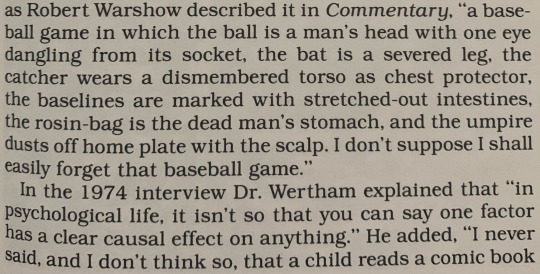



excerpt from Ron Goulart’s Great History of Comic Books, published in 1986
#comic book history#anti comics sentiment#fredric wertham#william gaines#leonard darvin#my posts#books
1 note
·
View note
Text
Thinking about the unintentional(?) homoeroticism of Silver Age World’s Finest Comics; how sociocultural factors in the 1950s made DC implement strong censorship and make everything silly and harmless so as not to be “inappropriate”; how Fredric Wertham railed against homosexuality in Batman comics; how this resulted in blatant sexism, racism, and heteronormativity in comics. And yet: Batman and Superman were consistently written as, well, pretty gay.
They both have female love interests (Lois Lane for Clark, I think Kathy Kane and Vicki Vale, among others, for Bruce), but in the Silver Age there was a consistent theme that these women were in constant pursuit of the men they loved, but Clark and Bruce always refused the possibility of romantic relationships with them (ostensibly because “crime-fighting and marriage don’t work well together”). The women were present to be The Heterosexual Love Interests, but despite that, the most well-developed relationship in World’s Finest (indeed, its emotional core) was that of Clark and Bruce. Their friendship consistently bordered on the romantic; all their emotional conflict and fulfillment was focused on each other. Plus there’s the fact that Clark effectively functioned as Dick’s second father.
Essentially, despite the systemic homophobia of the 50s and 60s, Batman and Superman were written as each other’s strongest emotional relationships, openly discussing their affection for each other as well as being physically affectionate. Their female love interests were basically there to dispel the idea of homosexuality.
I just!! Cannot believe! How beautifully gay these comics were during a time when the writers were trying to do exactly the opposite!
#world’s finest comics#worlds finest#batman#superman#bruce wayne#clark kent#superbat#dc#dcu#dc comics#silver age#silver age comics#robin the boy wonder#dick grayson#gay subtext#homoeroticism#meta
133 notes
·
View notes
Note
genuine question, how was like dc incest ships formed? like how did it all start :0
ooof that stretches back WAYYYYY back to like...the birth of dc comics. i'm no comic historian and i have limited knowledge for the rest of dc aside from batman but based on what i've read and know i'm 99.99% certain that the first ever batcest ship was between bruce and dick. and it became rather infamously known because of this psychologist named fredric wertham who sort of waged a war against comics- remember in like the mid 2000s when parents were clutching their pearls and saying videogames made kids violent?
well this was that, only with comic books and in the 1950-60s. he said comic books were filled with violence and sex and they would make kids violent and engage in sexually promiscuous behavior.
he directly addressed batman and robin's relationship calling it essentialy queercoded. his exact words about their relationship were:
"Several years ago a California psychiatrist pointed out that the Batman stories are psychologically homosexual. Our research confirms this entirely. Only someone ignorant of the fundamentals of psychiatry and of the psychopathology of sex can fail to realize a subtle atmosphere of homoerotism which pervades the adventures of the mature “Batman” and his young friend “Robin.” (p 189)
"Just as ordinary crime comic books contribute to the fixation of violent and hostile patterns by suggesting definite forms for their expression, so the Batman type of story helps to fixate homoerotic tendencies by suggesting the form of an adolescent- with-adult or Ganymede-Zeus type of love-relationship." (p 190)
"Sometimes Batman ends up in bed injured and young Robin is shown sitting next to him. At home they lead an idyllic life...They live in sumptuous quarters, with beautiful flowers in large vases, and have a butler, Alfred. Batman is sometimes shown in a dressing gown. As they sit by the fireplace the young boy sometimes worries about his partner: “Something’s wrong with Bruce. He hasn’t been himself these past few days.” It is like a wish dream of two homosexuals living together." (p 190)
my favorite is this one:
"The Batman type of story may stimulate children to homosexual fantasies, of the nature of which they may be unconscious. In adolescents who realize it they may give added stimulation and reinforcement."
translation:
the goddamn batman is going to make kids GAY
however there is one thing to note about what wertham was getting at: he was outraged that batman and robin were gay- not that they were incestuous. in fact, nowhere in the book does it mention anything about incest but i just ctrl + f searched that so it's possible they COULD have mentioned it, but if they did they didn't call it "incest".
outrage from conservative parents and "proper" communities of course meant they didn't want their kids reading this "filth". internet archive, which has a copy of this book you can read for free if you're interested in the quacky stuff he was trying to argue, has a footnote about the very REAL conseqeunces his publishing of this book had.
it was that "fredric's book and testimony at Senate Hearings within 6 months of his book publiation, was used to ban many comic books and an industry-wide self-censoring to be launched."
this is what led to the Comics Code Authority (1954). below i included a screen shot from wikipedia of a list of the things they censored and banned. you'll be able to note not a single bullet point mentions 'homosexuals' and that's because it fell under the umbrella of "Sex perversion". gay people were percieved as sexual predators by default then and still today they're viewed that way, though the conversation has shifted more towards pointing fingers at drag queens and trans people.
batcest has a pretty deep history and i could go on about how adam west and burt ward's flamboyant portrayal of batman only fanned the flames of the whole 'batman and robin are gay' thing but i think this small batman history lesson was enough.
even though the Comics Code Authority is no longer a thing, getting dissolved in 2011, i think you can still see the little threads of influence that remain and the fact that many of the writers and artists really don't have full creative freedom and control over the character they're writing for.
which is a shame. an enviornment where creativity isn't allowed to thrive is not an enviornment where it will survive.
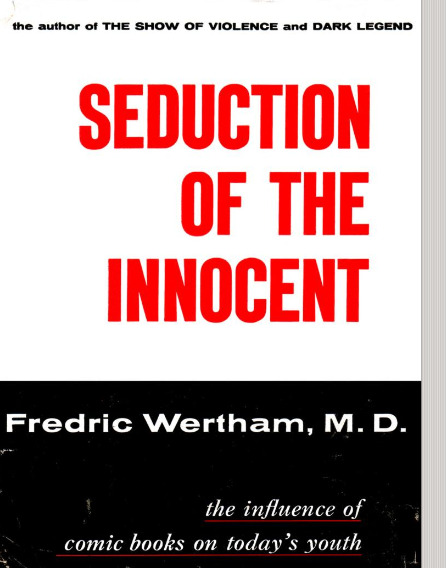
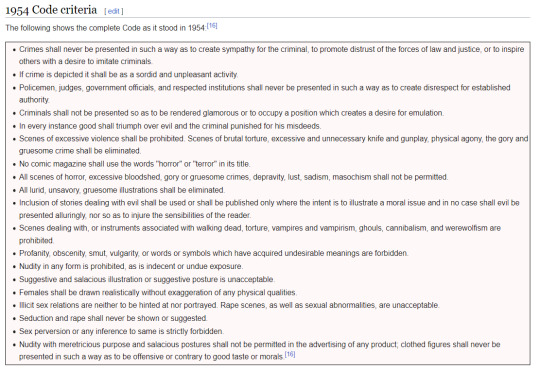
28 notes
·
View notes
Note
I wish antis would understand that even the “oh they have a sibling relationship, oh they have a parent/child relationship” isn’t going to A) stop people from shipping them, and B) stop assholes from homophobic about it. Comics Code existed because a guy called Fredric Wertham decided comics made kids be immoral, and also gay. The main example being Batman and Robin — no shade to shippers obvs — the explicit-since-day-1 father/son dynamic. Homophobes will never be appeased, so antis, stop trying
👆👆👆👆

30 notes
·
View notes